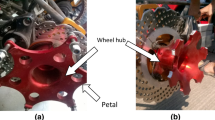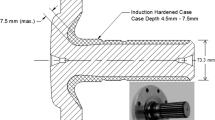Abstract
This paper details the failure analysis of a wheel hub from a student designed Formula SAE® race car that fractured at the roots of the rim finger attachment region. The wheel hub was identified to be manufactured from a rolled Al 6061 alloy. The experimental characterization included fracture surface analysis and microstructural analysis using scanning electron microscopy, as well as compressive stress–strain testing and micro-hardness testing to determine its mechanical properties. Analysis of the fractured surfaces of the hub revealed beach marks and striations, suggesting a fatigue failure. A kinematic model was developed to determine wheel hub loadings as defined by the car driving history. Detailed loads calculated from a kinematic equilibrium model and material properties obtained from the experiment results were used in a finite element model to simulate the stress distribution and fatigue life of the wheel hub. The wheel simulation results were consistent with the failure mode determined from the fractography study.















Similar content being viewed by others
References
U. Kocabicak, M. Firat, Numerical analysis of wheel cornering fatigue tests. Eng. Fail. Anal. 8(4), 339–354 (2001)
B. Zhang, D.M. Maijer, S.L. Cockcroft, Development of a 3-D thermal model of the low-pressure die-cast (LPDC) process of A356 aluminum alloy wheels. Mater. Sci. Eng. A 464(1–2), 295–305 (2007)
C.-L. Chang, S.-H. Yang, Simulation of wheel impact test using finite element method. Eng. Fail. Anal. 16(5), 1711–1719 (2009)
Forging Equipment, Materials and Practices, Air Force Materials Laboratory, Metals and Ceramics Information Center, Ohio, 1973, p. 13. 1973
F. Chiesa, Influence of some processes and metallurgical factors on production of cast Al wheels. AFS Trans. 103, 547–556 (1995)
ASTM Standard E9-09, 2009, “Standard Test Methods of Compression Testing of Metallic Materials at Room Temperature”, ASTM International, West Conshohocken, PA, 2009, doi:10.1520/E0009-09, 2009
P. Nageswara Rao, R. Jayaganthan, Effects of warm rolling and ageing after cryogenic rolling on mechanical properties and microstructure of Al 6061 alloy. Mater. Design 39, 226–233 (2012)
U. Kang, H. Lee, W. Nam, The achievement of high strength in an Al 6061 alloy by the application of cryogenic and warm rolling. J. Mater. Sci. 47(22), 7883–7887 (2012)
N.E. Dowling, Mechanical Behavior of Materials: Engineering Methods for Deformation, Fracture, and Fatigue (Prentice-Hall, New Jersey, 1993)
G. Totten, Fatigue crack propagation. Adv. Mater. Process 166(5), 39–41 (2008)
E.R. Jones, R.L. Childers, Contemporary College Physics (McGraw-Hill Science Engineering, Ohio, 2000)
R.L. Norton, Machine Design, an Integrated Approach (Prentice-Hall, New Jersey, 1995)
Aluminum Standards and Data 2000 and/or International Alloy Designations and Chemical Composition Limits for Wrought Aluminum and Wrought Aluminum Alloys (Revised 2001)
ASME Boiler & Pressure Vessel Code, 2013, Section III, “Rules for Construction of Nuclear Facility Components”, The American Society of Mechanical Engineers, New York, 2013
ASME Boiler & Pressure Vessel Code, 2009b, Section VII, Division II, “Alternative Rules, Rules for Construction of Pressure Vessels”, The American Society of Mechanical Engineers, New York, 2009
Federal Aviation Administration, M.M.P.D.a.S.M., DOT/FAA/AR-MMPDS-01, Office of Aviation Research, Washington, D.C., 2003
R.I. Stephens et al., Metal Fatigue in Engineering (Wiley, New York, 2001)
Acknowledgments
The authors thank the Center for Advanced Vehicular Systems at Mississippi State University for usage of the equipment for the materials characterization and mechanical experiments. In addition, we would like to thank Dr. Andrew Oppedal and Ms. Melissa Mott for their guidance.
Author information
Authors and Affiliations
Corresponding author
Appendix
Appendix
The mathematical description of the quasi-static equilibrium state was developed by summing and setting equal to zero the forces in each global coordinate direction, and the moments about each global and local coordinate axis. From summation of forces in the global x, y, z coordinate direction separately, obtained Eqs 4–6.
Summing the moments along global x, y, z coordinate axis resulted in the following Eqs 7–9.
Summing the moments about the local X′, X″, Y′ coordinate axis obtained Eqs 10–12.
where \(\mu_{\text{s}}\) is the dynamic frictional coefficient, and \(h\) is the distance between the gravity center and the ground. These reaction forces corresponding to the hard turn conditions can be calculated from the above equations, and the unknown forces for hard left turn were solved and are shown in Table 3.
In the straight driving condition, since the gravity center is centrally located with respect to the wheels and there is no acceleration, it was assumed that the weight was evenly distributed to each wheel and no side loads imposed on the wheels.
Rights and permissions
About this article
Cite this article
Song, W., Woods, J.L., Davis, R.T. et al. Failure Analysis and Simulation Evaluation of an Al 6061 Alloy Wheel Hub. J Fail. Anal. and Preven. 15, 521–533 (2015). https://doi.org/10.1007/s11668-015-9969-9
Received:
Revised:
Published:
Issue Date:
DOI: https://doi.org/10.1007/s11668-015-9969-9




